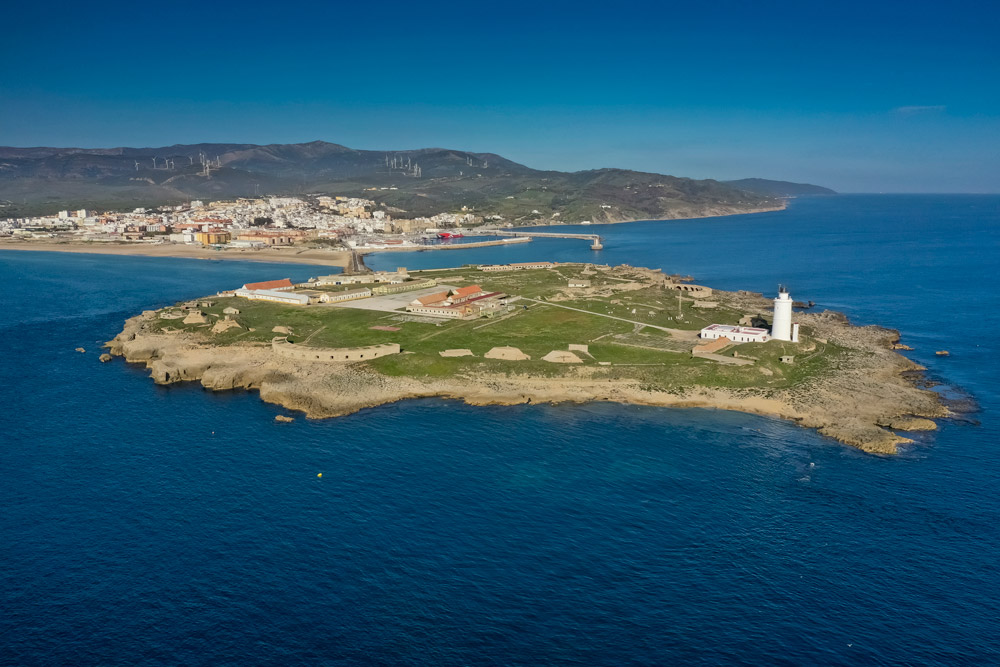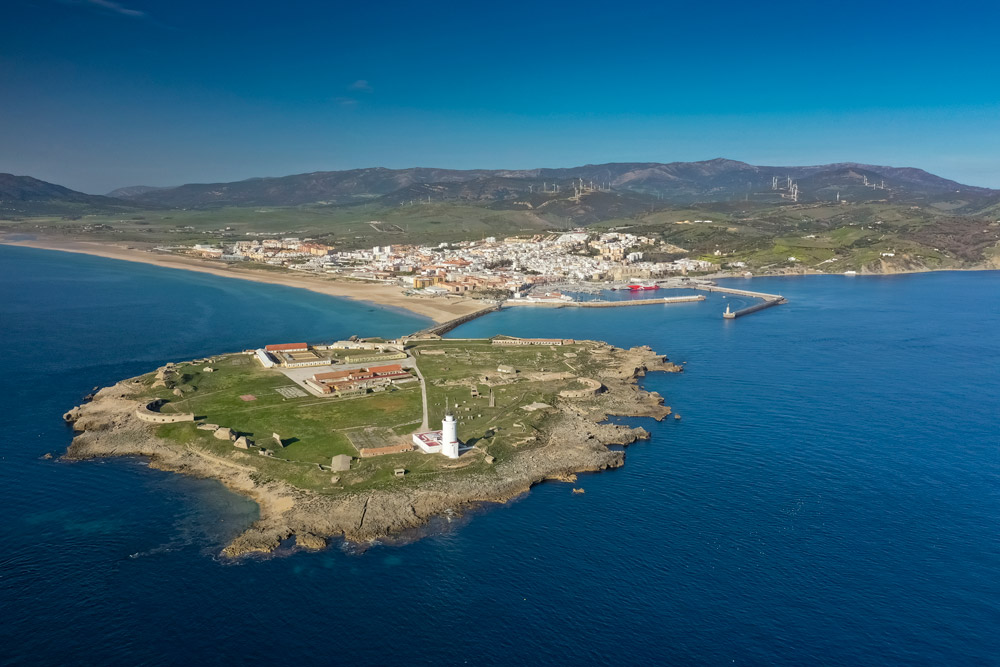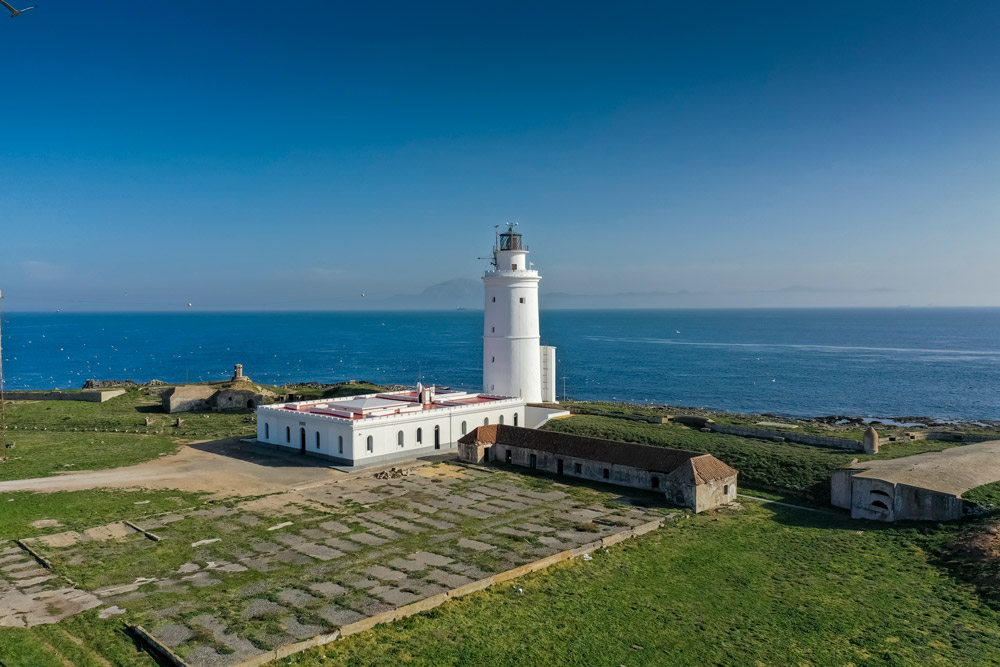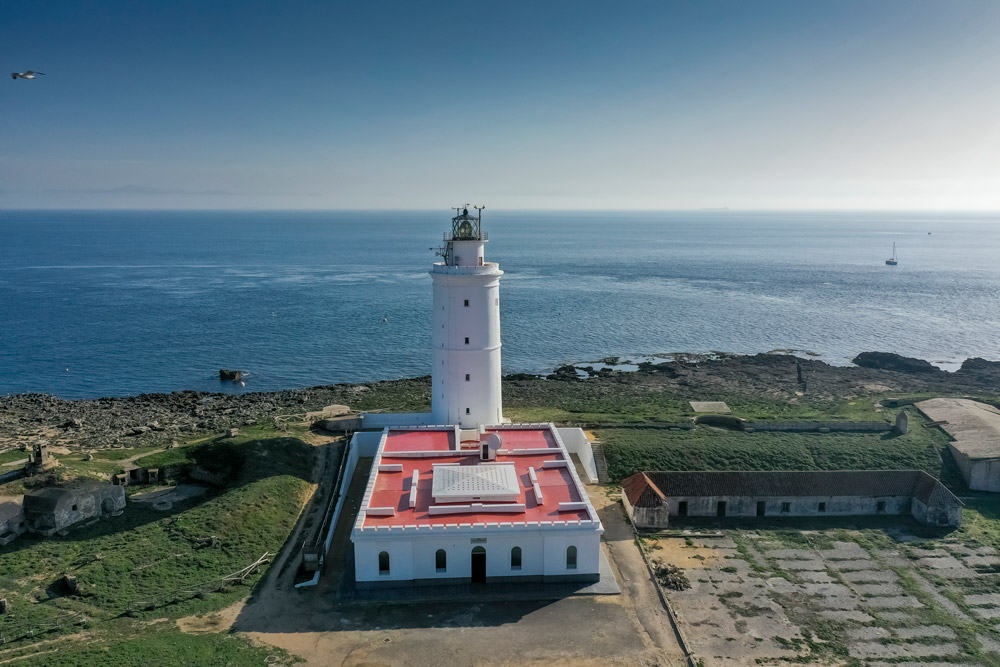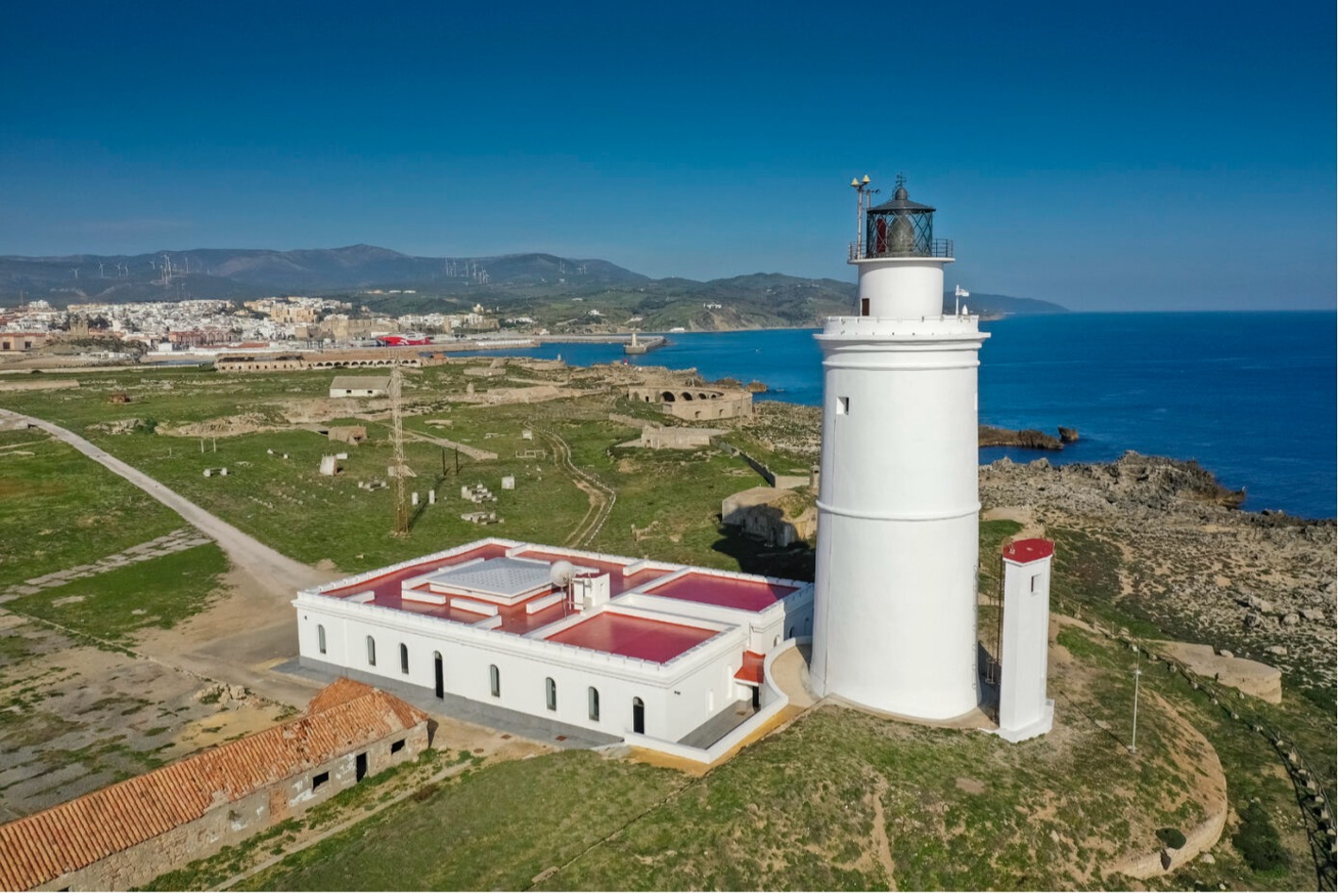Optical Array Details
- Location: Tarifa, Isla de las Palomas.
- Coordinates: 36º 0.069' N 005º 36.577' W
- Signal Type: Lighthouse
- Height: 33m
- Light Source: Rotary Lantern fitted on a mercury barrel; and activated by a Chance Brothers clockwork mechanism.
- Focal Length: 700mm
- Year: 1915
- Colour: White; Red sectors on Los Cabezos Shoals.
- Light & Sound Character: Groups of 3 x 10-second flashes (L: 0, 4, occ. 1, 8; L: 0, 4, occ. 1, 8; L: 0, 4, occ. 5, 2)
- Remarks: White cylindrical tower; Red sectors on Los Cabezos Shoals; Visible 113° B 089° R 113°
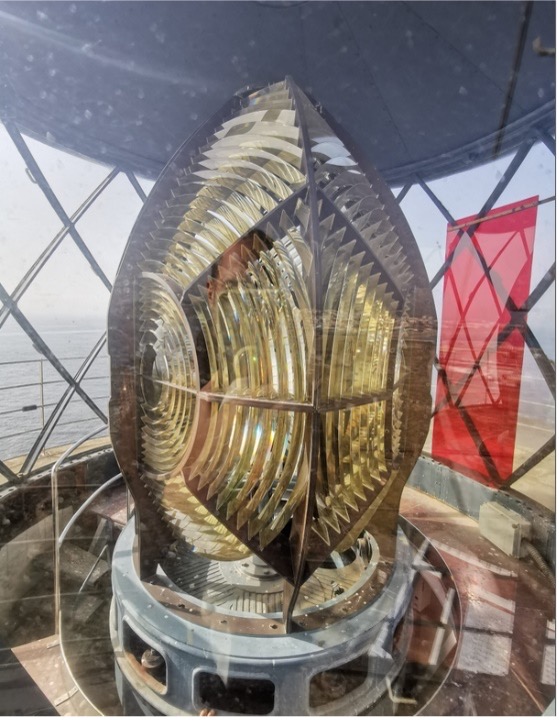
Map of Location & Visibility
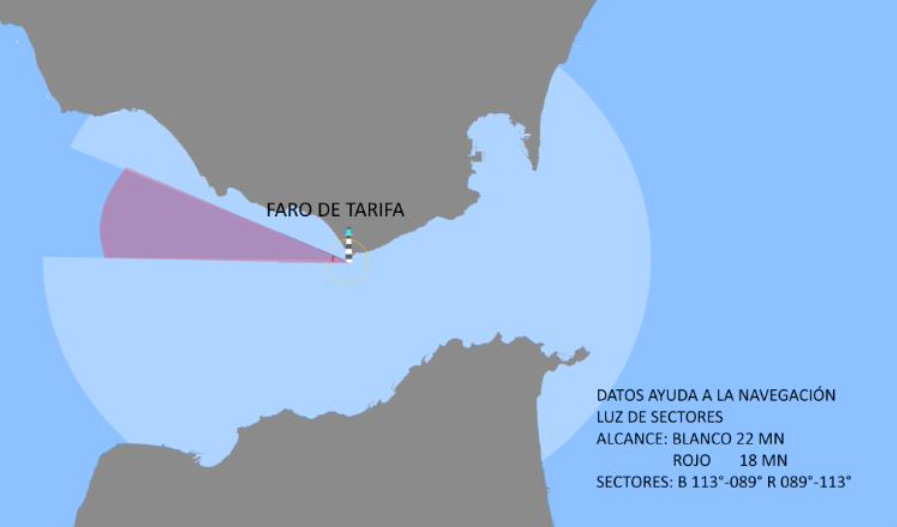
History
Erected on top of an old watchtower that had been built at the Southernmost tip of Tarifa Island, under orders of King Felipe II in 1588,
the original Project to convert the tower into a lighthouse goes back to 1799. This project was drafted by the marine engineer Tomas Muñoz: he conceived the idea of a lighthouse twice as high as the original watchtower and providing a lesser, third structure to support the lantern or beacon.
PDespite the works being commenced by the Campo de Gibraltar Engineering Command, works were postponed pending the uppermost section and lantern. This was finally resolved in 1811 – with the War of Independence raging through Spain – when the Regency Council decreed that the General & Extraordinary Parliament in Cadiz should provide the lighthouse with a rotary beacon for ships that sailed the Straits. The final works were concluded by the honorary military governor, Antonio Gonzalez Salmeron, who had originally insisted on this rotary solution to the Regency Council. Incidentally, Gonzalez Salmeron is also credited with joining the island to the mainland via a stone causeway built on top of the underlying reef
On completion of the works in 1813, the lighthouse was lit for the first time that year with a provisional fixed white beam, as it was not fitted with a rotary reflector system until 1822.
Prior to the first ever General Plan for Maritime Lighting, passed in 1847, Tarifa Island Lighthouse kept its guise as a masonry stonework tower until it was rendered in mortar and painted white: the current characteristic white we can see today.
At the end of 1863, a project – drafted by the civil engineer Jaime Font y Vila – was approved to provide keepers’ cottages and a storage building next to the primitive tower. It was separated from the tower by a gallery that ran under the embankment of the Lighthouse Artillery Battery, which made up part of the island’s military defences. This particular fortification allowed cannons to be transferred in service from one side of the tower to the other, and stop debris from the tower falling onto the building, should it be hit and destroyed. Once construction work had started at the turn of the year, it would not see completion until 1866. It was then enlarged twice in 1929 and 1931, allowing it to retain its original lines.
At the time, the lighthouse took on several alterations to its appearance; such as the one in 1869, when it was provided with a fixed red lantern to avoid it being confused with the lighthouse on Cape Spartel (built with a white lantern on the Moroccan coast five years earlier). It was also provided with a screen to the West, to signal the treacherous Los Cabezos Shoals. In 1887, a sector of its light was suppressed – two cables out from La Perla Shoals – to signal this hazard to shipping in tandem with the newly-built lighthouse on Punta Carnero in Algeciras. However, it would not be until 1907 when three white flashes became Tarifa Lighthouse’s established pattern; and, separately, a red sector of light was provided, now signalling the dangers of Los Cabezos Shoals in tandem with the new lighthouse at Punta Paloma, in 1899.
Electrification came in 1967, and then the lighthouse became fully-automated from 1996 on. One year later, it became part of a system of remote maritime beaconing. At the time, the four last lighthouse-keepers in active service were still living in the keepers’ cottages in the building adjacent the lighthouse until 1992, when the new Ports Act terminated the Maritime Signalling Mechanical Technical Corps and the lighthouse finally came under control of the Port of Algeciras Bay Authority, on the following 1st January. The last of those lighthouse-keepers remained at home in the keepers’ cottages until 2005.
Heritage & Conservation
- Included into the General Declaration under the Spanish Historical Heritage Act (Law 16/1985, 25/06/1985 and registered as an Asset of Cultural Interest in Official Govt. Bulletin Nº 155, 29/06/1985) by the 25/06/1985 Decree; and under a special acknowledgement normally granted to castles by the Andalusian Government in 1993.
- Registered as a Cultural Asset of Interest (Real Estate) under the name of “Tower of Las Palomas Island” under the General Catalogue of Andalusian Historical Heritage..
General Catalogue of Andalusian Historical Heritage - Put forward for declaration as a Cultural Asset of Interest on the initiative of the College of Civil Engineers in October, 2006.
- Registered as a Cultural Asset of Interest with a specific nature – along with the combined defensive military structures on Las Palomas Island – under the General Catalogue of Andalusian Historical Heritage, in 2017.
- Included into the Lighthouse Catalogue as a Heritage Asset of the Ministry of Education, Culture & Sports by the Spanish Heritage Institute, in 2017.
- Included into the Port of Algeciras Bay Authority’s Conservation & Historical Asset Enhancement Plan, in 2021.
Features
- Tarifa Lighthouse is located on Tarifa Island (or Las Palomas Island), an island that has been connected to mainland Europe by an artificial reef since 1808: a beautiful enclave that now belongs to the Strait of Gibraltar Natural Park
- The lighthouse was erected on top of a 16th Century watchtower that had been commissioned by King Phillip II and built in 1588.
- It was the first lighthouse to be purposely built to light the waters of the Strait of Gibraltar, in 1813; and, therefore prior to the 1847 General Maritime Lighting Plan.
- It is the southernmost lighthouse in all the continent of Europe.
- It still retains its fast-rotating optical array and 700mm focal length, fitted on a mercury barrel; and activated by a Chance Brothers clockwork mechanism, acquired in 1915.
- The lighthouse has been classified a Cultural Asset of Interest and included into the Andalusian Historical Heritage Catalogue, by virtue of the Spanish Historical Heritage Act (Law 16/1985, 25/06/1985; Official Govt. Bulletin Nº 155, 29/06/1985).
- The keepers’ cottages adjacent the lighthouse were home to the last lighthouse-keeper until 2005.
- Since the end of 2021, it houses Tarifa Island Visitor Centre – together with the lighthouse interpretation centre – which has allowed the public at large to visit and find out more about the life of lighthouse-keepers in olden days.
Find out more
- Tarifa Lighthouse – the First to Light the Strait of Gibraltar
- Tarifa – the Southernmost Lighthouse. Notes on the History of the Strait of Gibraltar’s First Lighthouse
- A Watchtower Full of Technology
- The Last of Tarifa’s Lighthouse-Keepers
Visits
Since 2021, the old tenement buildings located next to Tarifa Lighthouse has housed Tarifa Island’s Interpretation & Visitor Centre, managed by Tarifa Council under license from the Port of Algeciras Bay Authority.
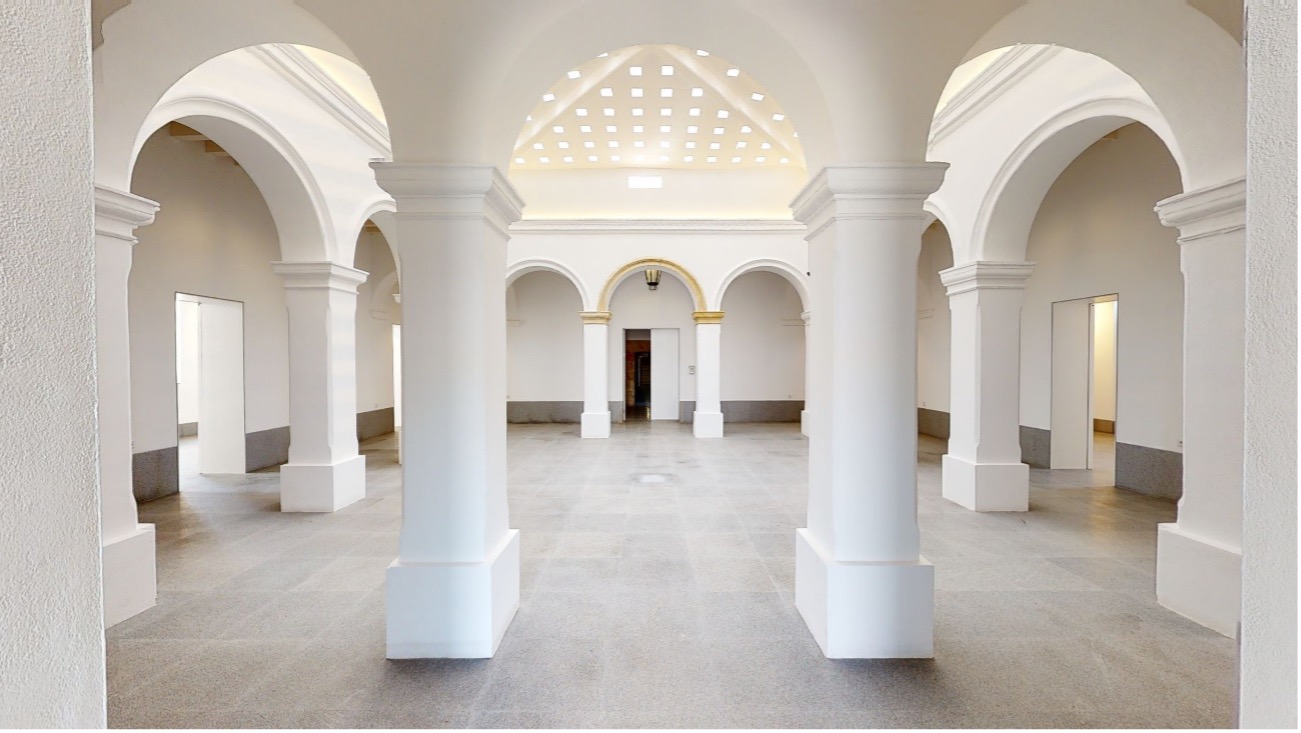
Video
Find out more about the Tarifa Lighthouse in the following videos:
Watch Video about Tarifa Lighthouse
Watch Video about the Tarifa Island Interpretation Centre
Photo Galery
